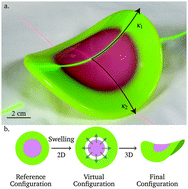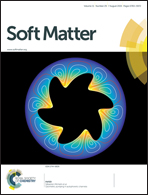Morphing of geometric composites via residual swelling
Abstract
Understanding and controlling the shape of thin, soft objects has been the focus of significant research efforts among physicists, biologists, and engineers in the last decade. These studies aim to utilize advanced materials in novel, adaptive ways such as fabricating smart actuators or mimicking living tissues. Here, we present the controlled growth-like morphing of 2D sheets into 3D shapes by preparing geometric composite structures that deform by residual swelling. The morphing of these geometric composites is dictated by both swelling and geometry, with diffusion controlling the swelling-induced actuation, and geometric confinement dictating the structure's deformed shape. Building on a simple mechanical analog, we present an analytical model that quantitatively describes how the Gaussian and mean curvatures of a thin disk are affected by the interplay among geometry, mechanics, and swelling. This model is in excellent agreement with our experiments and numerics. We show that the dynamics of residual swelling is dictated by a competition between two characteristic diffusive length scales governed by geometry. Our results provide the first 2D analog of Timoshenko's classical formula for the thermal bending of bimetallic beams – our generalization explains how the Gaussian curvature of a 2D geometric composite is affected by geometry and elasticity. The understanding conferred by these results suggests that the controlled shaping of geometric composites may provide a simple complement to traditional manufacturing techniques.


 Please wait while we load your content...
Please wait while we load your content...